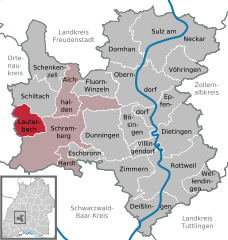Lauterbach, Baden-Württemberg
| Lauterbach | ||
|---|---|---|
|
The centre of Lauterbach with Catholic church St Michael | ||
| ||
 Lauterbach | ||
Location of Lauterbach within Rottweil district 
 | ||
| Coordinates: 48°14′43″N 08°21′37″E / 48.24528°N 8.36028°ECoordinates: 48°14′43″N 08°21′37″E / 48.24528°N 8.36028°E | ||
| Country | Germany | |
| State | Baden-Württemberg | |
| Admin. region | Freiburg | |
| District | Rottweil | |
| Government | ||
| • Mayor | Norbert Swoboda | |
| Area | ||
| • Total | 19.95 km2 (7.70 sq mi) | |
| Elevation | 579 m (1,900 ft) | |
| Population (2015-12-31)[1] | ||
| • Total | 2,972 | |
| • Density | 150/km2 (390/sq mi) | |
| Time zone | CET/CEST (UTC+1/+2) | |
| Postal codes | 78730 | |
| Dialling codes | 07422 | |
| Vehicle registration | RW | |
| Website |
www.lauterbach- schwarzwald.de | |
Lauterbach is a village in the district of Rottweil in Baden-Württemberg. Lauterbach is located in the Black Forest near Schramberg, and is known as a tourist resort.
Neighbouring towns and municipalities
The following towns and municipalities border on Lauterbach (clockwise, from N to W):
Wolfach, Schiltach, Schramberg and Hornberg
Land use
Lauterbach's total area of 19.95 km2 is covered by forest (55%) and is agricultural fields (37%), the rest (8%) is built-up area and roads.[2] Since Lauterbach is embedded into the narrow valley of the Lauterbach River there is not much space for erecting residential homes or industrial buildings. Residential expansion – although rather limited – is only possible in the outskirts.
History and political development

The first documented mentioning of Lauterbach – although disputed – is in 1101 AD. The small village was part of the territory of Schramberg (Herrschaft Schramberg),[3] which was sold to Habsburg in 1583. So for 222 years Lauterbach was Austrian.[4] In 1805, as a result of Napoleon's defeat of the Austrian Emperor the area was passed on to the new Kingdom of Württemberg. Its district capital was Oberndorf am Neckar. In 1938 Schramberg and Lauterbach were incorporated into the Rottweil district,[5] which changed from the Administrative Region of Tübingen to Freiburg in 1973.[6]
An attempt, in 1997/98, to incorporate Lauterbach into the city of Schramberg, was turned down by the Lauterbach voters in a referendum on 1 March 1998. There is, however, co-operation with Schramberg and the neighbouring municipalities of Hardt and Aichhalden in a number of administrative fields, e.g. land utilization and zoning.
There is also regional co-operation in the field of tourism with Schramberg and the neighbouring towns in the Kinzig and Gutach valleys (Schiltach, Hornberg, Wolfach).
Economy
There has never been any large-scale industrial development in Lauterbach. Most of the inhabitants found jobs in the nearby clock and watch industry in Schramberg. Some small and medium-sized enterprises and the classical trades are typical of the small Black Forest village. A comb factory was founded in the late 19th century. The largest enterprise today is a plastic factory, which serves as a supplier to other German and European manufacturers.
At the end of the 19th century tourism was initiated and had a boom after World War II.
Education and culture
Lauterbach has two kindergartens (one in Sulzbach and one in Lauterbach) and one elementary school, which comprises primary school, secondary school and – as of late – what is called Werkrealschule, which offers pupils additional lessons and allows them to qualify after ten years with a final exam which is equal to graduation from Realschule.
Any further secondary or vocational education is provided by the respective schools (Realschule, Gymnasium and various vocational schools in Schramberg.
Social and cultural life in Lauterbach is characterized by a large number of voluntary associations.
Initiated by and named after the painter Wilhelm Kimmich (see notable persons), there is a gallery which offers exhibitions and concerts attracting visitors from far and near.
Notable persons born in Lauterbach
The orthopedist Johann Georg Heine (1771–1838) and the discoverer of poliomyelitis Jakob Heine (1800–1879). The Black Forest painter Wilhelm Kimmich (1897–1986).
Karl and Oskar Buchholz won the world championship for Germany in cycle ball five times between 1959 and 1964 and Werner and Jürgen King were world champions in cycle ball three times in the early 1990s.
Honorary citizens
List of persons awarded honorary citizenship (in German) here
References
- ↑ "Gemeinden in Deutschland nach Fläche, Bevölkerung und Postleitzahl am 30.09.2016". Statistisches Bundesamt (in German). 2016.
- ↑ Information given by town administration
- ↑ There is a detailed online coverage of the history of this territory here
- ↑ Bumiller, Casimir, Rüth, Bernhard: Die Herrschaft Schramberg im Verbund der österreichischen Lande, in: Schramberg, Adelsherrschaft – Marktflecken – Industriestadt, Schramberg 2004
- ↑ Theiss, Konrad und Baumhauer, Hermann (ed.): Der Kreis Rottweil, Stuttgart-Aalen 1963
- ↑ details of this administrative reform here
| Wikimedia Commons has media related to Lauterbach (Schwarzwald). |
.jpg)
